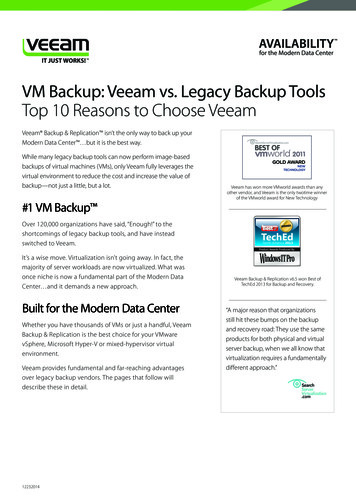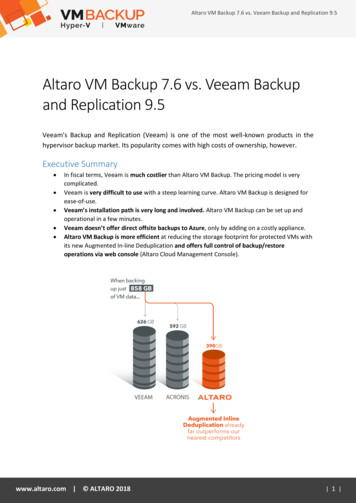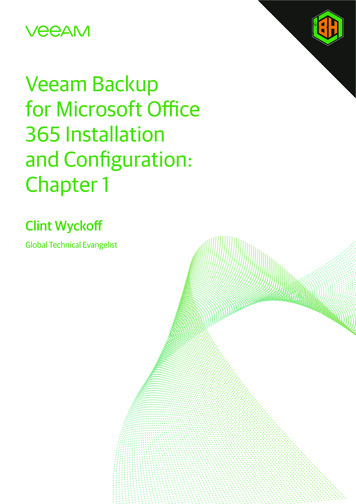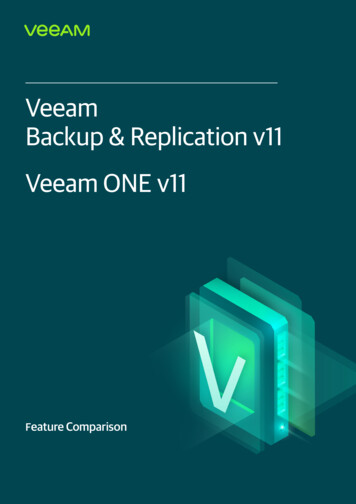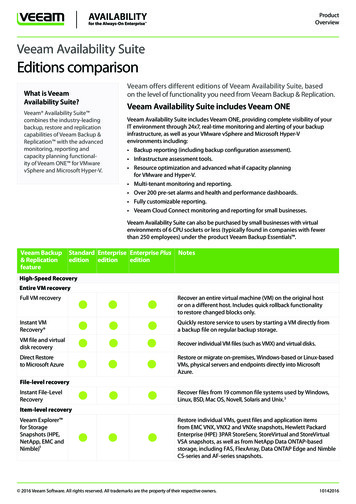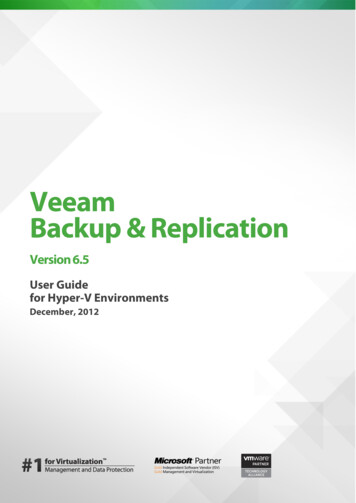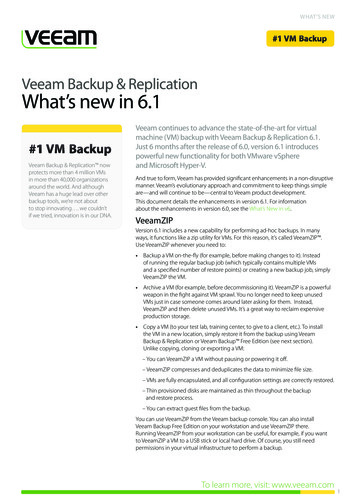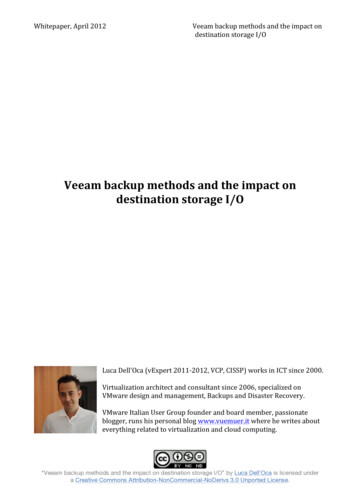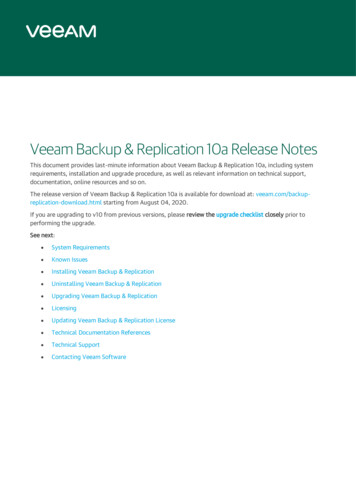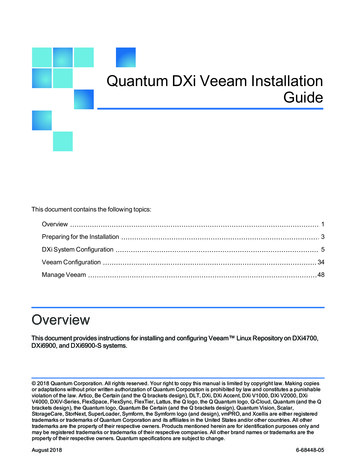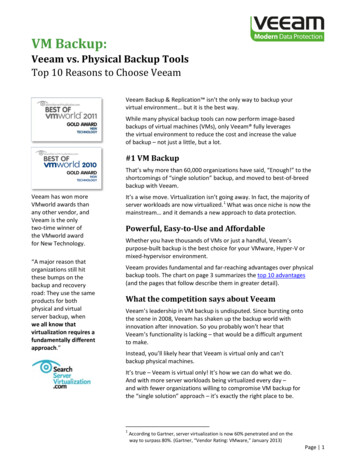
Transcription
VM Backup:Veeam vs. Physical Backup ToolsTop 10 Reasons to Choose VeeamVeeam Backup & Replication isn’t the only way to backup yourvirtual environment but it is the best way.While many physical backup tools can now perform image-basedbackups of virtual machines (VMs), only Veeam fully leveragesthe virtual environment to reduce the cost and increase the valueof backup – not just a little, but a lot.#1 VM BackupThat’s why more than 60,000 organizations have said, “Enough!” to theshortcomings of “single solution” backup, and moved to best-of-breedbackup with Veeam.Veeam has won moreVMworld awards thanany other vendor, andVeeam is the onlytwo-time winner ofthe VMworld awardfor New Technology.“A major reason thatorganizations still hitthese bumps on thebackup and recoveryroad: They use the sameproducts for bothphysical and virtualserver backup, whenwe all know thatvirtualization requires afundamentally differentapproach.”It’s a wise move. Virtualization isn’t going away. In fact, the majority ofserver workloads are now virtualized. 1 What was once niche is now themainstream and it demands a new approach to data protection.Powerful, Easy-to-Use and AffordableWhether you have thousands of VMs or just a handful, Veeam’spurpose-built backup is the best choice for your VMware, Hyper-V ormixed-hypervisor environment.Veeam provides fundamental and far-reaching advantages over physicalbackup tools. The chart on page 3 summarizes the top 10 advantages(and the pages that follow describe them in greater detail).What the competition says about VeeamVeeam’s leadership in VM backup is undisputed. Since bursting ontothe scene in 2008, Veeam has shaken up the backup world withinnovation after innovation. So you probably won’t hear thatVeeam’s functionality is lacking – that would be a difficult argumentto make.Instead, you’ll likely hear that Veeam is virtual only and can’tbackup physical machines.It’s true – Veeam is virtual only! It’s how we can do what we do.And with more server workloads being virtualized every day –and with fewer organizations willing to compromise VM backup forthe “single solution” approach – it’s exactly the right place to be.1According to Gartner, server virtualization is now 60% penetrated and on theway to surpass 80%. (Gartner, “Vendor Rating: VMware,” January 2013)Page 1
Solving the 3C problemPhysical backup tools suffer from the “3C” problem: lack of capabilities, complexity and cost.But Veeam uses virtualization – and Veeam innovation – to solve the 3C problem.ExamplesIssueVeeam o agents to deploy, monitor or maintainCostAffordableDeduplication, Microsoft Exchange recovery, SAN snapshotsupport 3 and more included at no extra chargeVerify the recoverability of every backup, 2 and restore anentire VM or an individual file or email in 2 minutes – allfrom the same image-based backupBuilt for VirtualizationMost backup tools were built for the physical world and simply retrofitted for virtualization.Their roots are in the physical world, which constrains what they can do for virtual machines.But Veeam is different – Veeam is Built for Virtualization, and it shows. For example:Physical backup tools Veeam Require agents inside eachVM for granular recovery andproper application backupand recovery.Is completely agent-free –agents are not used toperform or assist withbackups, and agents are notused for recovery either.While others claim to be agent-less(no data mover agent), only Veeamis agent-free.Difficult to find VMs ornavigate the virtualinfrastructure.Is intuitive and easy-to-use.Veeam feels like it was builtfor virtualization because itwas!As one Veeam customer put it:“Our legacy backup tool felt like abolt-on piece of equipment – likeprotecting the virtual environmentwas an afterthought. Veeam feelslike it was built specifically tosupport VMs.”Often take months toprovide support for newVMware and Hyper-Vreleases – and even then,support is often just basiccompatibility.Provides the best support forVMware and Hyper-V.Because virtualization is all we do,Veeam can provide better, fasterand deeper hypervisor-specificsupport.Veeam doesn’t simply tolerate the virtual environment – we embrace it. By harnessing the disruptivepower of virtualization, we provide data protection beyond anything you could have imagined. OneVeeam customer calls it “science fiction come true.” We call it Virtualization-Powered Data Protection,and it changes what you should expect – and what IT stakeholders and regulators will ultimatelydemand – from backup.23Currently available for VMware; will be available for Hyper-V in Veeam Backup & Replication v7.Currently available for VMware.Page 2
Of course, we can’t take all the credit. It’s virtualization that makes what we do possible Likerecover a virtual machine in 2 minutes from a backup. Automatically test the recoverability ofevery backup. And eliminate agents – even for advanced application recovery.Look closelyMost backup tools have their roots in the physical world, and some capabilities are not availablewith image-based VM backups. For example, some physical backup tools might offer syntheticfull backups for traditional file-based backups, but don’t have this capability for image-based VMbackups. Likewise, OS-level replication or log-based replication for select applications might beavailable, but not image-based VM replication.About this comparisonThis comparison was created at the request of Veeam customers and prospects to help themevaluate their options for VM backup. To the best of our knowledge, the information is correctas of the date of publication.We would appreciate your feedback. If you see something here that’s different from what youknow or have experienced with physical backup tools, please let us know.Veeam vs. physical backup toolsWhen it comes to VM backup, Veeam provides numerous advantages – both technical andcommercial – over physical backup tools. Here are the top 10 advantages according to Veeamcustomers and partners:Physical Backup ToolsVeeamBackup & ReplicationSymantec, CommVault,Avamar, AppAssure, etc. 2. Support for VMware and Hyper-VDeepBasic3. ValueHighLowAny OS and file systemWindows, maybe Linux 6. Instant application-item recovery2Any application, on any OSSelect applications only7. Automated recovery verification2 8. Ease of useHighLow9. Storage friendlyHighVaries10. Near-CDP 1. Agent-free4. Instant file-level recovery5. Instant VM recoveryBut don’t just take their word for it – click on any point to learn more, then try Veeam Backup &Replication for yourself.Page 3
1Agent-freePhysical backup tools rely on agents, and they apply this approach to VM backups as well. Somecan do a basic crash-consistent, image-based VM backup without an agent (for example, usingVADP, the vSphere APIs for Data Protection). But they still require agents inside VMs foressential functions like granular recovery and application-consistent backups.Even if agent licenses are included ‘for free”, agents add cost to backup and recovery. Worseyet, they introduce risk. Considerable time is requiredto deploy, monitor andmaintain agents in every VM.Backup agents in VMs canalso create compatibilityissues and complicatetroubleshooting for “real”VM workloads.The time required tomaintain agents translatesto real costs.Agents also consumeserver resources and canreduce savings from serverconsolidation.!Agents don’t protect: Powered-off VMs Newly provisioned VMs VMs with outdated agentsor missing prerequisites VMs whose agents can’tcommunicate with thebackup server(for example, due tonetwork isolation)Veeam eliminates all these issues by eliminating the need for agents. How do we do it? By fullyembracing virtualization, which itself eliminates the need for agents:VADP (for VMware) andstandard Windows APIs (forHyper-V) eliminate the needfor data mover agents insideVMs.Image-based backups(which capture the entireVM) eliminate the need forapplication and file systemindexing and the agentsthat perform it.If properly designed, theremaining guest processingcan be done by a lightweight,non-persistent run-timeprocess, eliminating the“maintenance nightmare”and other problemsassociated with agents.Veeam performs advanced backup and recovery without the use of agents in VMs. This doesn’tmean that Veeam lacks features – such as application-aware backup and recovery, applicationlog truncation, granular application-item recovery, Windows guest file searching, or in-placerestores – that physical backup tools require agents to deliver. Veeam provides all thesefeatures and more without agents in VMs.(back)Page 4
2Support for VMware and Hyper-VVM backup sounds simple enough on paper, but in practice it’s more complicated.VDDK: For example, VMware provides a powerful toolkit (VDDK, the Virtual Disk DevelopmentKit) for backup vendors, but how a vendor integrates with VDDK has a big impact on thereliability of their backups and restores. Veeam carefully architected its VDDK integration toensure the highest reliability.VSS: Another example of Veeam’s deep hypervisor expertise and attention to detail is our VSSintegration. VSS (Windows Volume Shadow Copy Service) is the mechanism provided by Microsoftto quiesce (or “quiet”) Windows applications prior to backup. Rather than relying on VMware Toolslike most backup vendors do, we built our own integration to VSS to ensure application-consistencyof Veeam backups. Our advanced VSS integration also performs specific backup and restore stepsfor Microsoft Exchange and Active Directory, as per Microsoft’s requirements.Changed block tracking: By focusing on virtualization, Veeam is able to provide the best supportfor VMware and Hyper-V, including change block tracking for Hyper-V that works even for VMson CSVs (cluster shared volumes).Deep expertise in a single solutionVeeam’s hypervisor expertise runs deep – for both VMware and Hyper-V – and Veeam supportsboth hypervisors from a single console and with a single backup infrastructure. Veeam evenoffers the flexibility to move Veeam licenses between VMware and Hyper-V hosts at no charge.So as your virtual environment changes, Veeam has you covered.With more than 10 million VMs protected, there isn’t much we haven’t seen. We sweat thedetails so you don’t have to.As agile as virtualization itselfOur focus on VM backup also keeps us agile. So Veeam is able to provide better and fastersupport for new hypervisor releases.Many physical backup tools are large, complex systems that attempt to cover a lot of bases –physical and virtual, and often data protection, data management and data archiving, too.Because VM backup is just one part of a much larger system, it can be quite some time beforethe physical backup vendors support new hypervisor releases and longer still before customersare able to upgrade their production deployments of these complex systems.When new hypervisor support is finally available, it tends to be simple “checkbox” compatibility.Veeam, on the other hand, is specifically Built for Virtualization. As a result, Veeam typicallyprovides new hypervisor support months before the physical backup vendors. For example:October2009Veeam was the first to support VADPwith the release of Veeam Backup &Replication 4.0.Some physical backup vendorstook more than a year to addsupport for VADP.November2012Veeam was the first to support bothvSphere 5.1 and Windows Server 2012Hyper-V, including the new VHDX virtualhard disk format and VMs on SMB3.Some physical backup vendorsclaimed support for WindowsServer 2012 Hyper-V, but didn’tsupport VHDX or SMB3.Veeam Backup & Replication also has fewer moving parts, so it’s much easier for customers toupgrade. As a result, Veeam customers are often on the latest versions of VMware and Hyper-Va year or more before their peers who are encumbered by their organizations’ decision to applyold tools to the new (and fundamentally different) environment.(back)Page 5
3ValueVirtualization doesn’t just change the mechanics of data protection – it also changes theeconomics. For example, you can restore a VM on any host, so you don’t need to maintainexpensive standby hardware. And virtualization’s host-based licensing approach is good newsfor customers looking to rein in backup costs.But just as physical backup vendors were slow to adopt image-based backups, they also clung toold machine-based, à la carte pricing.Veeam, on the other hand, embraced the virtual paradigm from the start – both from atechnical perspective and from a commercial perspective. Veeam licensing is based solely onhost processing power. There are: No per-VM license fees No per-application license fees No license fees for backup infrastructure – deploy as many backup servers, proxies andrepositories as you like. Even the centralized management console is free. No long list of feature add-ons. Deduplication is even included at no charge. First-year maintenance is included.Stay agilePhysical backup customers complain that not only are those tools expensive, but pricing is quitecomplicated, with many separately licensed agents, features and components (media servers,management consoles, etc.). In some cases, simpler per-terabyte pricing is available, but it istypically quite expensive.When there are changes in the virtual environment, these customers report that it can take daysor even weeks to determine the correct licensing, effectively robbing them of the agility theysought to achieve through virtualization.But Veeam pricing is affordable and predictable. Backing up additional hosts is a simple matterof adding more CPU sockets. The backup infrastructure can be expanded or reconfigured asneeded at no additional charge.Spend lessOf course, software licenses and maintenance aren’t the only – or even the biggest – costs youincur for backup. Veeam reduces total cost of ownership (TCO) by offloading backup processingfrom hosts and VMs and minimizing consumption of backup storage and network bandwidth.Veeam also reduces administrative overhead. Customers report that Veeam is easier to use thanphysical backup tools: Backup and recovery operations are easy to understand and execute. Backups run reliably – there’s no need to babysit backup jobs. There’s no need to constantly tune and tweak jobs because Veeam’s intelligent loadbalancing automatically adjusts to changes in your dynamic virtual infrastructure. The backup infrastructure is easy to setup and maintain. There no agents for you todeploy, monitor or maintain, and Veeam even takes care of updating backup proxiesand repositories for you.Page 6
Get moreVirtualization isn’t only about spending less – it’s also about getting more. And Veeam followsvirtualization’s lead on that front, too. For example, Veeam provides: 2-in-1: backup and replication: Don’t just backup VMs – replicate them to standby hostsfor the best possible recovery objectives. (Read about near-CDP for more details.) Free e-discovery and item recovery for Exchange: Get instant visibility into ExchangeVM backups for easy e-discovery and item recovery. Search mailboxes and mailboxstores, and retrieve individual items (emails, contacts, notes, etc.). Free support for SAN snapshots:3 Restore individual VMs, guest files and Exchangeitems directly from HP StoreVirtual snapshots. On-demand sandbox:2 When you need a test or training environment, let Veeam create it foryou. Veeam’s patent-pending vPower technology runs VMs directly from compressed,deduplicated backup files, so you don’t need additional storage. And Veeam’s Virtual Labtechnology creates an isolated environment using available host resources. With Veeam, youcan put your backups to work every day.Does your physical backup tool give you all this?(back)Page 7
4Instant file-level recoveryUnlike traditional file-based backups, image-based backups allow for quick recovery of an entireVM on any host, without having to rebuild the system from scratch. But recovery of individualguest files can be a challenge.Given that file-level recoveries are the most common recovery scenario – often occurring on adaily basis – this challenge must be overcome in order for organizations to adopt image-basedbackups.First to marketFrom the very beginning, Veeam has provided file-level recovery from image-based backups. Infact, Veeam invented Instant File-Level Recovery (IFLR), which allows IT admins to restore guestfiles directly from a compressed and deduplicated image-based backup, without having torestore the entire VM first (that’s why it’s called “instant”).IFLR was initially available for Windows and then for Linux, Unix and Mac file systems usingpatent-pending Veeam technology based on an IFLR helper appliance.Extending the leadWith support for 16 different file systems, Veeam already holds a substantial lead over otherbackup tools. And with vPower, Veeam has extended its lead, with the ability to restoreindividual files from any guest OS and file system, without restoring or starting up the VM at thedesired restore point.1-Click File RestoreVeeam further extended its lead with 1-Click File Restore, which allows organizations to securelydelegate Windows file restores to help desk operators. 1-Click File Restore: Leverages guest interaction APIs Requires no agents in VMs Requires no additional permissions for help desk operators Can be limited to direct restores only (so operators never have access to sensitive files) Can be limited to specified file typesGood enough?Some physical backup tools offer file-level recovery for Windows (and in some cases, Linux)VMs, but special indexing of each backup is typically required.!If you forget to enable the special indexing, file-level recovery is not possible.!If your environment can’t tolerate the additional processing, file-level recovery is notpossible.!File-level recovery for many OSs and file systems is not possible at all.!In-place restores, if available, typically require agents in VMs.(back)Page 8
5Instant VM recoveryVeeam’s vPower technology runs a VM directly from a compressed and deduplicated backup fileon regular backup storage. This patent-pending, groundbreaking technology eliminates the needto extract the backup and copy it to production storage – you simply start the VM from thebackup (that’s why it’s called instant). So if a VM goes down, you can restart it on any host in amatter of minutes. Users can keep working why you troubleshoot the problem.Back in a snapIn an independent lab test commissioned by Veeam, it took under 1.88 minutes to do an instantrecovery of a 200GB VMware VM, compared to 2.4 hours for standard VM recovery from animage-based backup on disk using a physical backup tool. That’s 77 times faster!Furthermore, the time to do an instant recovery with Veeam remained under 2 minutes, even asthe size of the VM increased.An instant recovery of a 16GB Hyper-V VM took just 7 seconds, compared to 9.95 minutes forstandard VM recovery from an image-based backup. That’s 85 times faster! And once again, thetime to do an instant recovery remained essentially unchanged even as the size of the VMincreased.Back to normalVeeam Instant VM Recovery is like a “temporary spare” for your VMs. To complete the recovery,Veeam will migrate the VM running from the backup to production storage for you, using thebest method available (VMware Storage vMotion, Hyper-V Live Migration, SCVMM migration,Veeam migration, etc.). Depending on the method, full recovery can happen in the background,with no interruption in service or impact on users.Not even closePhysical backup tools have no equivalent instant recovery capability. They may try to expediterecovery with “live recovery” of data volumes or “CBT restore”, but they still operate within theconventional “restore then restart” paradigm. Furthermore, CBT restore:!Doesn’t work in many common recovery scenarios, including VM deletion and loss of acomplete LUN.!Introduces additional risks due to not restoring blocks that are “known” to vSphere asunmodified, but that might have been corrupted on storage by the incidentprecipitating the restore.!Doesn’t support Hyper-V.(back)Page 9
6Instant application-item recovery 2Veeam’s vPower technology enables recovery of individual objects from any virtualizedapplication, on any OS, without restoring the entire VM first (that’s why it’s called instant).For example, you can recover: Individual items from your corporate email system Individual rows and tables from an Oracle database running on Solaris Individual customer records from a Unix-based CRM systemWe call it U-AIR , or Universal Application-Item Recovery. It’s an innovative, patent-pendingsolution to the age-old problem of what to do when users accidentally delete important emailsor scripts incorrectly update records.How it worksThe idea is actually quite simple: Since it’s easy to start up a VM on the fly, what if you could runthe application from the disk-based backup (in an isolated environment, of course) and retrievethe items you need? That way, you could perform granular recovery for any virtualizedapplication, any time, without special agents or backups.It sounds simple enough—it is easy to create VMs, and it’s relatively straightforward toconfigure an isolated virtual network. But what about the time it takes to provision storage andextract the backup? And what happens if the VM running from the backup interferes with theVM running in production?This is where Veeam takes a deceptively simple concept and turns it into a powerful new reality.Veeam’s vPower technology runs a VM directly from a compressed and deduplicated backupfile. There’s no need to provision storage or extract the backup – you simply run the VM directlyfrom the backup file on regular backup storage, but without making any changes to the backupfile itself.And Veeam’s Virtual Lab technology creates an isolated environment where backup VMs canrun without risk of interfering with the production environment. Veeam even provides a proxyappliance to make it easy to copy items from the isolated environment to your productionenvironment.What it means for youU-AIR addresses the limitations of existing object-level recovery methods. U-AIR is: Inexpensive: doesn’t require agents, additional backups or additional software tools. Universal: works with any virtualized application and the application’s nativemanagement tools and permissions. Durable: not tied to application internals so is easy to maintain and works seamlesslywith new application patches and releases.Page 10
The alternativeSome physical backup tools offer object-level recovery, but:!Object-level recovery is available for only a few specific applications.!Special agents are required. In many cases, separately created backups or specialmetadata collection is also required.!The additional backup processing can be quite resource-intensive and/or slow, socustomers often limit their use of object-level backup and recovery – for example, onlydo granular backups of executives’ mailboxes.!If the special processing fails for any reason (even if the backup job reports success), youcannot recover application items at all.(back)Page 11
7Automated recovery verification2Of course, you can’t do any sort of recovery – instant or otherwise – if your backup is bad. Buthow do you know if your backup is bad? Even if a backup job completes successfully and thebackup file passes its integrity check, you might not be able to recover from the backup. Forexample:!The system you’re backing up may be in an unbootable state – for example, a criticalconfiguration file or registry key might have been deleted or corrupted.!There might be installation, update or system reconfiguration tasks pending reboot.!A hot backup might have captured the system or application data in an inconsistentstate.The only way to be sure that you can recover from a backup is to do a test restore. All thebackup vendors know this. But testing every backup is simply not possible unless you haveVeeam.Veeam SureBackupVeeam SureBackup allows you to verify the recoverability of your backups – not just a fewselected backups, but every backup, of every VM, every time.This patent-pending technology: Automates the recovery verification process Uses available resources in the existing production or test environment Does not affect your backup windowDuring recovery verification, SureBackup: Creates a VM in an isolated Virtual Lab (which Veeam automatically creates and thenremoves for you). Runs the VM directly from the backup file using vPower. Starts the VM, boots the OS and confirms that applications inside the VM are runningnormally. Can even test a group of dependent VMs (such as a DNS server, domain controller andExchange server).Don’t settle for lessYou no longer have to settle for backups that “might work” or “should work”— instead, you canrest easy knowing that your backups actually do work.(back)Page 12
8Ease of useAlthough ease of use is difficult to measure, it has a big impact on the cost and effectiveness ofbackup. Therefore, ease of use must be part of any evaluation of backup tools.Being Built for Virtualization, Veeam has a huge advantage over physical backup tools. Ratherthan retrofitting an existing tool built for a different time and place, Veeam was built from theground up specifically for virtualization. Every aspect of Veeam is designed for virtualization –including core concepts, product architecture, the processing engine, workflows, and the userinterface.Intelligent load balancingVeeam is built to accommodate the dynamic nature of the virtual infrastructure and virtualizedworkloads.Unlike some physical backup tools, Veeam does not tie VMs or backup jobs to particular backupcomponents. Veeam’s intelligent load balancing automatically determines the best backupproxy at run-time and dynamically assigns a backup proxy to each VM. As you add or removebackup proxies – or as your workload changes –Veeam automatically adjusts. So you don’t haveto constantly update and tweak backup jobs, which: Saves time Eliminates backup failures Helps ensure backups complete in the available windowDistributed architectureVeeam also features a distributed architecture that: Easily scales to support thousands of VMs Streamlines deployment and maintenance in remote offices and branch offices (ROBO)Not only is it possible to scale up, it’s also practical to do so. Veeam backup servers automatically deploy and update backup proxies and backuprepositories. No matter how many proxies and repositories you have, your only point ofadministration is the backup server. Veeam’s centralized management console – Veeam Enterprise Manager – providesmonitoring and reporting across your entire distributed backup infrastructure.It just works!If you talk with Veeam customers, comments you’ll likely hear include: It just works! Anyone in IT can do a restore – it’s that easy. I sleep better night thanks to Veeam.For organizations struggling with VM backup, that’s reason enough to change.(back)Page 13
9Storage friendlyVeeam is storage-agnostic, so you can use it with any mix of production and backup storageacross data centers, remote offices and disaster recovery (DR) sites. Customers appreciate thisflexibility, which: Avoids vendor lock-in Optimizes storage spend Makes it easy to integrate acquired companies Allows old storage to have a new life as backup storageStorage savingsVeeam also makes the most efficient use of backup storage. With business stakeholdersdemanding more frequent backups and with data volumes growing 30–50% annually, 4 storagemust be used as efficiently as possible.Veeam takes a multi-pronged approach to reduce the size of backups (which also minimizesconsumption of network bandwidth):4DeduplicationMany VMs have the same operating system and/or applications installed,making image-based backups ideal candidates for deduplication. That’s whyVeeam included deduplication from the beginning – in fact, Veeam was the firstvendor to implement deduplication in a VM backup product. Veeam’s inlinesource-side, block-level deduplication typically results in a 10x reduction innetwork traffic and backup storage consumption. And it’s included at no charge.CompressionTo further reduce backup size, Veeam can also compress backup files.WhitespaceremovalVM disks often contain empty blocks, and Veeam excludes these from backupsto save space.Swap fileexclusionData contained in swap files isn’t necessary when recovering VMs or VM data, soVeeam excludes them from backups.Single backupWith Veeam, you only ever need one backup – regardless of what kind ofrecovery operation you might need to perform. Full VM recovery, granularapplication-item recovery and instant file-level recovery are all available fromthe same image-based backup for any virtualized application and any guest OS.No extrametadataUnlike some backup tools, Veeam collects no special metadata in order toperform granular application-item or file-level recovery. Not only does thisminimize overhead and speed backup, it also reduces backup size.Forrester Research, Inc., “Controlling Storage Amid High Growth,” February 3, 2010Page 14
“Foreverincremental”backupsSynthetic full backups eliminate the need for periodic full backups by creatingnew full backups from incremental backups. This “forever incremental”approach to backup is both proven and desirable because it reduces load on theproduction environment.In fact, forever incremental is the only way to protect very large VMs that wouldotherwise take the better part of a day – or even longer – to backup (even withthe fastest and most efficient backup tool). Likewise, forever incremental isessential when backing up offsite over a WAN.Synthetic full backup can also reduce backup storage requirements by60 percent or more. For example, say you have a 100GB VM and yourorganiz
(no data mover agent), only Veeam is agent-free. Difficult to find VMs or navigate the virtual infrastructure. Is intuitive and easy-to-use. Veeam feels like it was built for virtualization because it was! As one Veeam customer put it: "Our legacy backup tool felt like a bolt-on piece of equipment - like protecting the virtual environment
